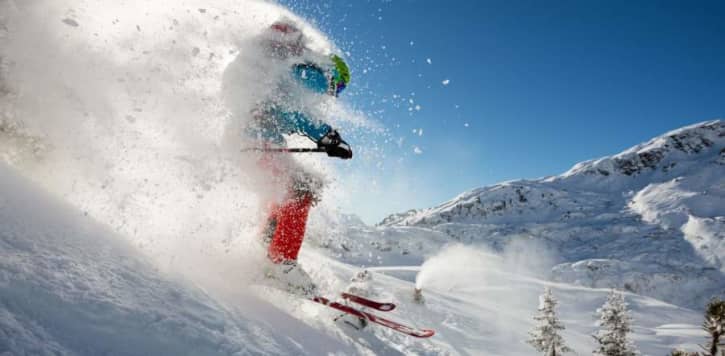Keeping your face warm on the slopes can be the difference between having a great time and being miserable. There's nothing worse than trying to do a run only to have cold wind and snow whipping your face without mercy. Having failed to properly protect my face on past ski trips, I know first-hand that it can be a total buzzkill.

But not to worry. With a little planning, you can keep your entire face nice and toasty throughout the entire day.
Contents
1. Get a Proper Balaclava
Getting a proper balaclava is going to be your first and best line of defense for keeping your face warm.
A balaclava is a piece of head-wear that has the ability to cover your entire face besides your eyes. They're generally pretty-form fitting and can be coupled with a hat or preferably a helmet for safety.
But what separates a good balaclava from the bad?
In my experience, you don't want to get a balaclava that doesn't have a mechanism to keep moisture away from your mouth. Without such a mechanism, moisture will build up when you breathe or unintentionally lick your lips on the fabric. When it's really cold out, that moisture will freeze and make you even chillier.
Read Also: Best Buff for Skiing - Top 5 Options
There are two ways that balaclavas are designed to reduce moisture build up:
- A large mesh portion that takes up the space around the nose and mouth
- An air hole around the mouth by which the user can breathe through directly
The balaclavas with the air holes are made exclusively from a company aptly named "Airhole."
What I'm Using: Right now, I'm using the Ergodyne N-Ferno which has served me well thus far. Check out my full review on it here.
2. Insulated Helmets
After your balaclava, your second line of defense for your head and face is an insulated helmet. This replaces the need for wearing an extra hat on top of your ski mask and also keeps you safer in case of a fall or crash.
Most, if not all, ski helmets you'll find on the market will be insulated. This insulation typically includes padded covers through the ears as well as cushioning throughout the inside of the helmet.
They should also have vents to let some cool air in so you don't overheat. In addition, they help eliminate the sweat that can accumulate during hard runs. Some of the more high-tech helmets will have vents that you can adjust. Adjustable vents give you a higher level of control over temperature and airflow.
3. Neck Gaiters & Warmers
If you've been watching the 2018 Winter Olympics, you'll notice that many of the skiers use neck fleeces. A neck fleece is usually a bit heavier and bulkier than a balaclava. The nice thing about them is you can very easily switch from covering just your neck to the entire bottom of your face.
If you're going the route of a neck fleece, you probably won't be using a balaclava. Your best bet for extra warmth will be combining it with a hat (if you're not going to wear a helmet) or an insulated helmet and helmet liner.
4. Helmet Liners or Skull Caps
Helmet liners, sometimes called skull caps, are basically just small beanies that wick away sweat and keep you warm. They're designed to fit directly under your helmet and not interfere with how the helmet fits.
It's really important that you don't try to fit any beanie or hat under your helmet and have it shift around. A thick hat isn't necessary with modern day ski helmets, and it will eliminate the added protection of wearing it in the first place.
5. Don’t Forget Goggles
People typically don't think of goggles as a way to keep warm, but they actually play a very important role. Not only do they help the skin on your face retain some heat, but they also protect the area from wind and snow blowing around.
6. Cover Up Before Going Outside
Even though it might seem a little too warm, make sure you get all of your head, neck, and face protection on before stepping out onto the mountain.
7. Grow a Beard
This option is reserved for men, but growing a thick beard can be a great way to protect your face from the cold. Even though a beard can be a place for ice to build up, this can actually work to your advantage.
There's a theory in the ski world that this frozen snow can actually act something like a second insulator. It's not coming in contact with your skin, so it can help keep some of that extra warmth in without it being cold. Kind of like an igloo for your face!
Wrapping Up
By now, you should have a pretty good idea how to keep your neck, face, and head warm when you're skiing. Obviously, you don't need to use all these tips and/or gear at the same time. Just one or two should make a huge difference and make your trip a lot more enjoyable.
Want to learn about how to keep your entire body warm?
Be sure to see the Complete Guide to Staying Warm While Skiing.






